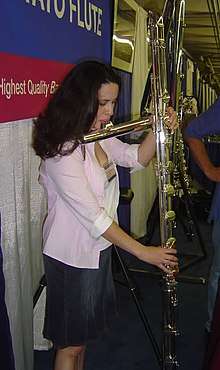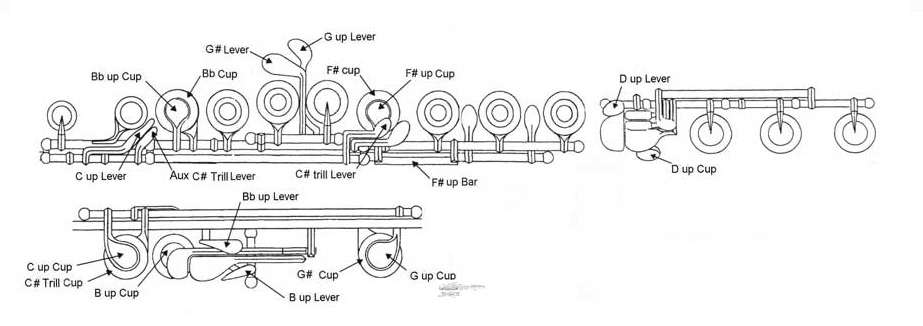Contra-alto flute
The Contra-alto flute or bass flute in the key of G, is a musical instrument of the woodwind family that plays sounds one octave lower than the alto flute.[1] It is a transposing instrument. The instrument's body is held either vertically or horizontally, with an adjustable floor peg similar to that of the bass clarinet. The contra-alto flute is primarily used to fill in harmonic and melodic voices between the bass and contrabass flute.[1] It is the baritone member of the flute family.

The instrument maker Eva Kingma calls her contra-alto flute a "contr'alto flute in G," and Kotato & Fukushima call their instrument "bass flute in F." Kotato & Fukushima's instrument sells for US$17,500.[2]
Contra-Alto Flute Origins
Large flutes have been in existence for several hundred years with earlier accounts of alto flutes being used for military use with a bore size of 26 millimeters, 7 millimeters larger than the C flute.[3] The exact date of the original alto flute which later developed into the contra-alto flute is unknown, however, early letter references in 1865 confirm alto flutes were long established.[3] An improved construction was documented in the 1850s by Theobald Boehm who improved the alto flute in G. Documented evidence states Boehm's creation was made roughly between 1854-1855. The first documented alto flute workshop appeared in January 1858 and was sold to Marcel Ciemmirski in Lemburg for 156 florins.
Before the Boehms reconstruction, the alto flute faced complications with inconsistent intonation, complicated cross fingerings, widely spaces holes, and general length.[3] Earlier versions were mainly suitable for large males to play with slight discomfort.[3] Original pieces forced musicians to stretch arms very far in order to reach left hand finger holes further from body of the tube.[3] Given the large size, the alto flute was obsolete until Theobald Boehm's work in the mid 19th century.[3] Boehm perfected the concert flute by improving its fingering system and creating key mechanisms such as adding levers to reduce finger stretches to ease playing conditions which were later adapted to the oboe and clarinet.[3] Boehm's system allowed players to switch from C flute to the G flute without leaning a new fingering system.
More recently, composers have adopted the terms 'Alto Flute in G', contr'alto flute in G, or 'Bass Flute in C'. Older works using the alto flute usually refer to the instrument as the Bass Flute in G. The instrument and its capabilities have significantly evolved since Boehm's developments by using different materials such as nickel silver and silver.[3]
Present-day contra-alto flute makers use unique key configurations, bore sizes, and materials in order to add variation in tone quality, hand positions, and response.[3] Key connection rods today and placed along the side flutes body.
The latest contra-alto flute is by the Kingma System which was developed by Dutch alto flute-maker Eva Kingma in the early 1990s.

Contra-alto Flute Repertoire
More flute ensemble repertoires are incorporating the contra-alto flute. Typically, it is doubled with the contrabass (and/or bass) flutes, however, in recent years, composers and arrangers such as Alexandra Molnar-Suhajda and Judy Nishimura have been pushing the boundaries of lowness by writing independent parts for the instrument.[4] Various orchestral scores feature the contra-alto flute including:
- Gustav Holst: The Planets, Op. 32 (1914)
- Peter van Munster: Repertoire Catalogue for Piccolo (2004)
- David Burnand: Night Scene (2001)
- Pierre Boulez: Le Marteau sans maître (1955)
- Coreen Morsink: Andromache’s Recitativo (2010)
- Michael Oliva: Apparition and Release (2005)
Alto Flute Repertoire
The contra-alto flute was developed using the origins of the alto flute which is associated with the scores of Igor Stravinsky and Maurice Ravel, who used the instruments in several scores. See alto flute.
- Bruno Bartolozzi: Cantilena (1911)
- Jonathan Bayley: Music for Pan (1982)
- Charles Delaney: Variations on the 'Seeds of Love' (1989)
- Jon Gibson: Untitled (1974)
- Philippe Hersant: Cinq Miniatures (1995)
- Edwin Roxburgh: The Curlew (1994)
References
- "CONTRA-ALTO FLUTE IN G: THE BASS ALTO FLUTE". 2019.
- Kingman. "Eva Kingman Flutemaker".
- Rees, Carla (2013). "The Kingma System Alto Flute: A Practical Guide for Composers and Performers". Altoflute.
- "NFA Flute Choir Reading Session" (PDF). 2019.